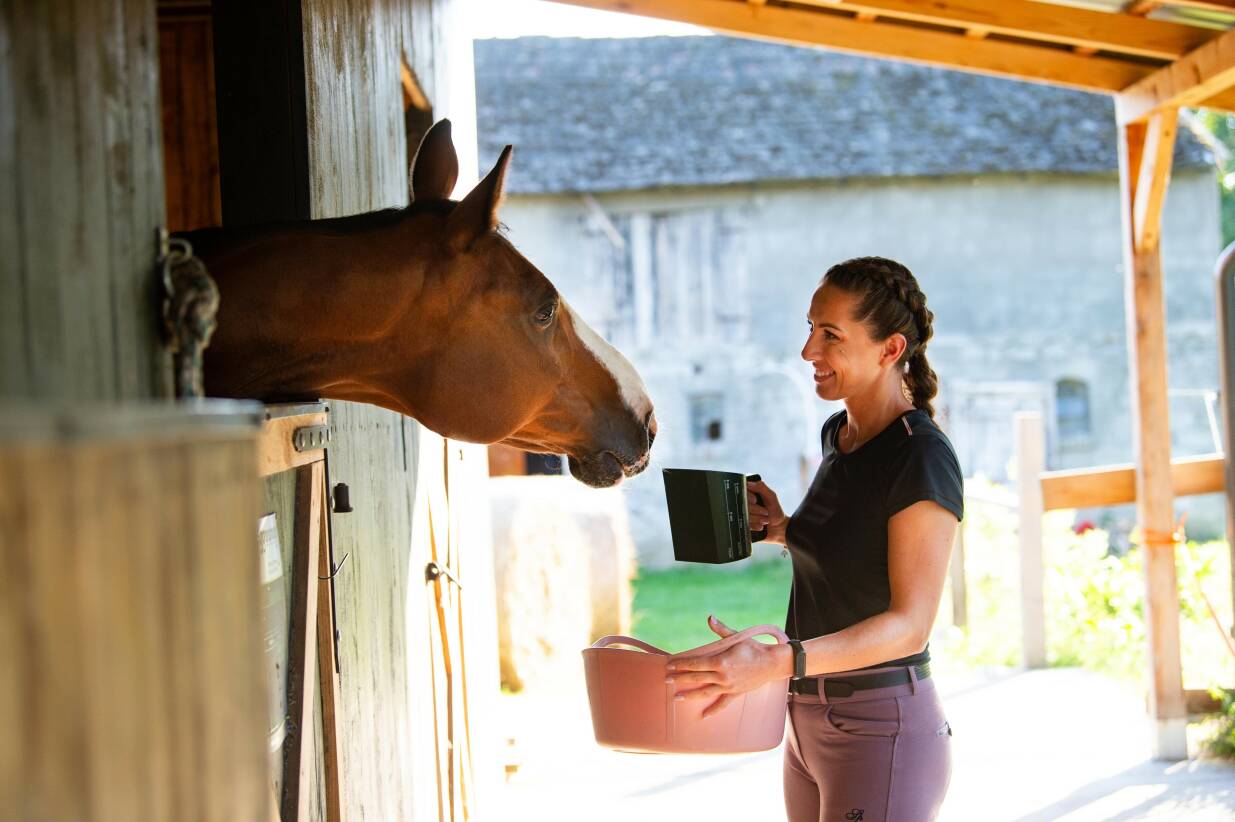Sources:
Professor Jo-Anne Murray, May 2020: The gut-brain connection in horses. Premier Performance
Succeed Veterinary Center, May 2023: The Relationship Between Bacterial Environment in the Gut and the Brain in Horses.
Roughage should be an important part of your horse's diet. Photo: Shutterstock
Stereotypic behaviour like cribbing for instance is a way for the horse to get close to the natural behaviour of chewing. Photo: Shutterstock

Diseases that might be connected to feeding:
Ulcers
Colic
Laminitis
Over- or underweight
Make sure you have good quality roughage and that you provide enough. Photo: Kamila Tworkowska
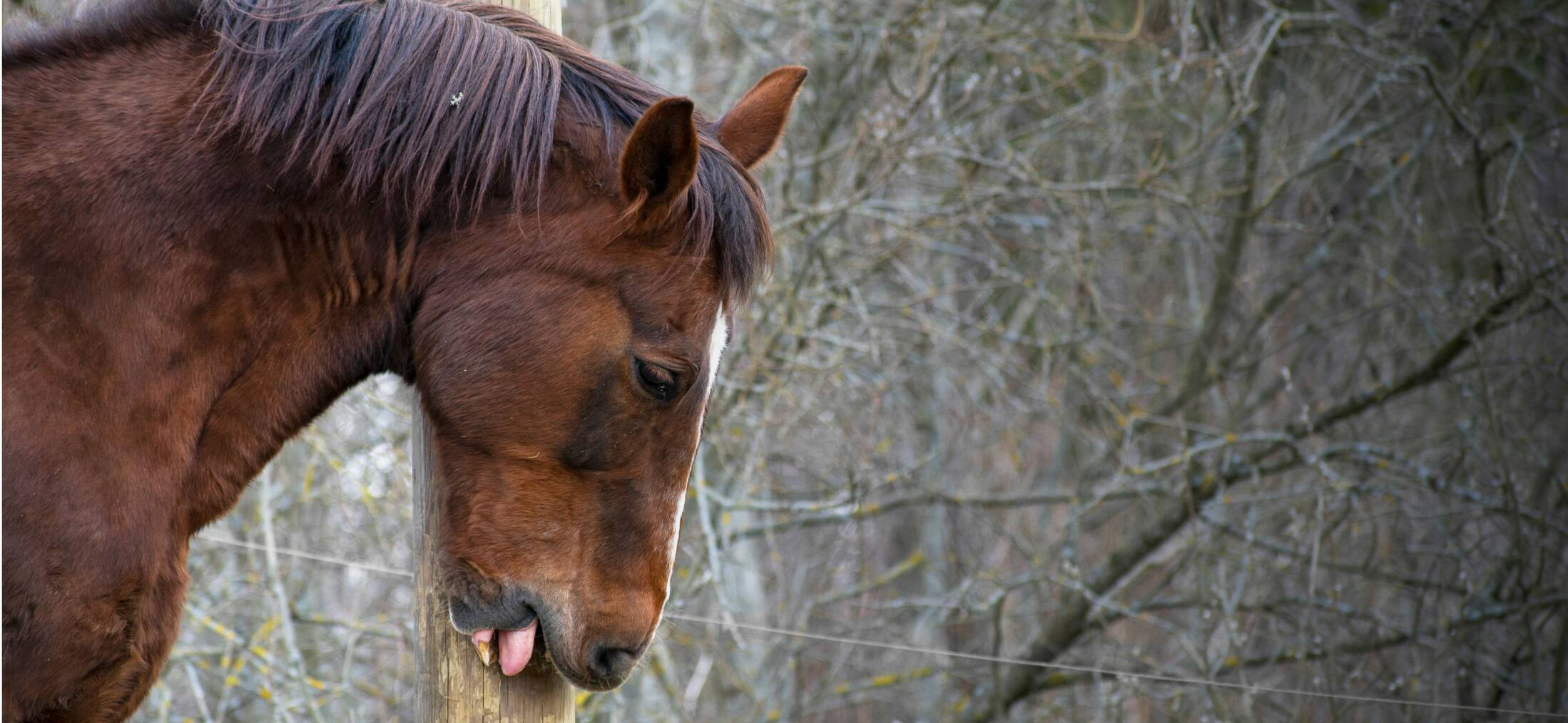
gut-brain connection
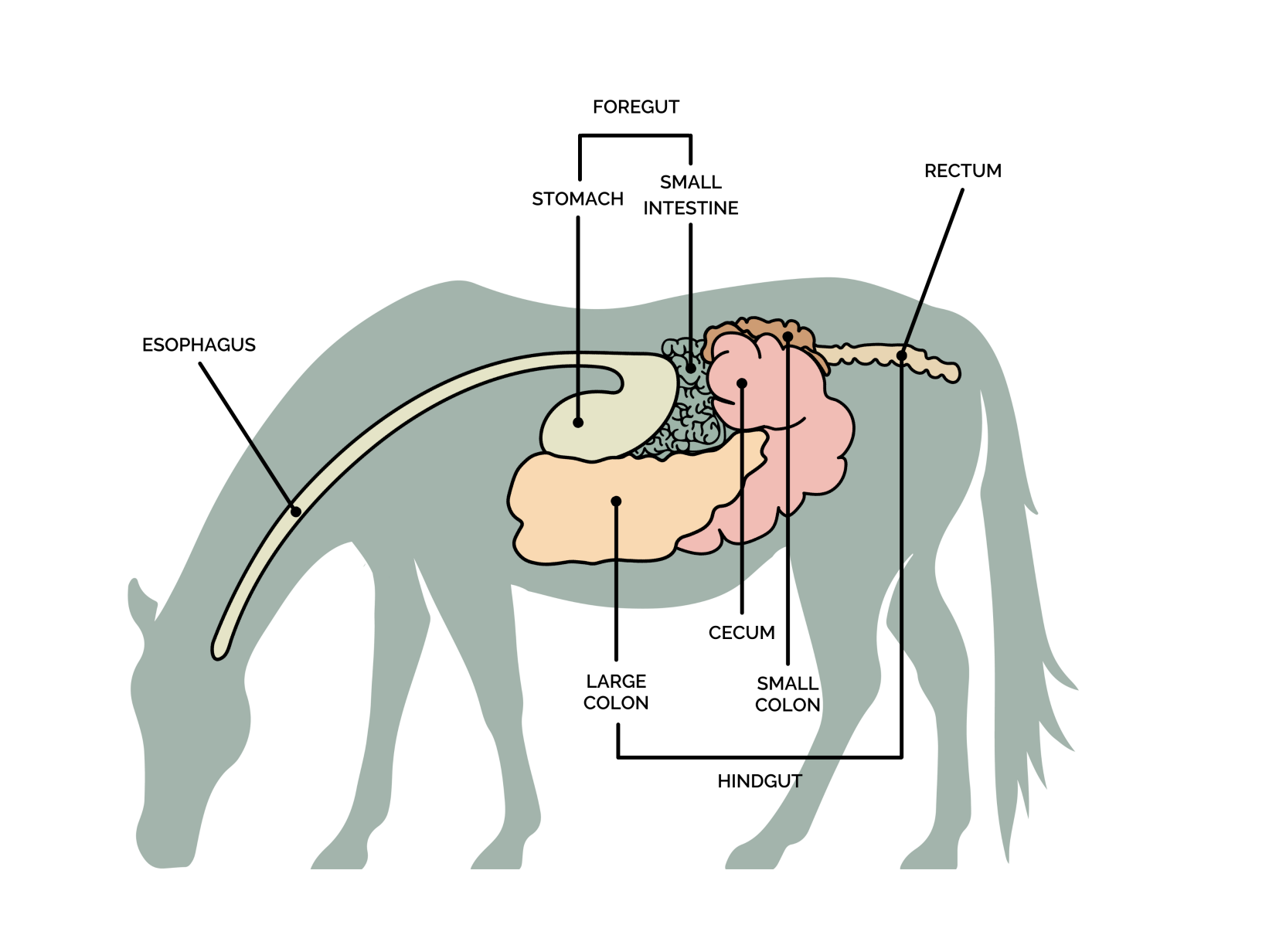
Since we keep our horses quite differently to the natural horse, it can be challenging to feed natural, but with some slight adjustments, we might get a little bit closer.
Even though we have a huge responsibility as horse owners, there is also a responsibility from the feeding industry. They are responsible for providing clear ingredient labels and transparency. When reading on the back of the feedbag, you might be confused by the many different things in the feed – and how do you figure out what is essential for your horse and what is not?
“It is first of all our responsibility as horse owners to make sure that we feed our horses in a right way. We need to learn how to understand the information on the feedbag,” Martha Voss explains. But no matter how hard we try to feed our horses the right way, we may still need some help from the feed industry.
“The feed industry have a moral responsibility to tell horse owners what is in their feed – and this goes for both hard feed and roughage. But it is a bit more difficult with the roughage than with the hard feed. In the hard feed there is a law about feed materials and what they contain – but since roughage is a raw material it gets a bit more tricky, and there is no law to declare what the feeding actually contains. So, that is why we need to demand the analysis of the roughage a lot more,” Martha Voss explains.
Feeding is an individual case, and hardly any owner feeds the same. But it shows that trends tend to spread throughout the communities and are ever-changing. We are constantly figuring out new ways to feed our horses.
“I sense that ‘low on sugar and starch’ became a plus word in a lot of feeding. But actually, it does not make that big a difference if the hard feed might be low on sugar and starch if the roughage is filled with it instead.”
How do you feed your horse? Do you know what your feed bags contain? Do not hesitate to contact an educated and experienced feed consultant. Many places offer a free consultation. Remember that you are responsible for your horse's physical and mental well-being.
Owners, as well as feed industry, are responsible
“If your horse starts to get aggressive you need to react and might as well have a further look at the feeding. We must understand that we cannot just not treat symptoms. And we must figure of what causes the symptoms.”
Martha Voss explains.
Today, we keep our horses in the stable for a lot of hours and often without enough roughage – or roughage in a quality that is not suitable for horses. When we see problems – mentally or physical – in our horses we often end up buying a lot of different subsidies instead of looking deeper into the environment we are offering our horses. An environment, that is very far away from the horse's natural environment. In nature, the horse would spend around 17 hours browsing, walking and searching for food. It would eat small rations with a lot of fibres throughout day – but that is far from how most horses are kept today.
When something is wrong within the stomach, it will often cause, what we perceive as, unwanted behaviour and a lot of diseases. Of course, feeding is not always the reason, but looking at the feeding can be a good place to start. We need to know, how well connected the horses’ gut and brain is connected.
Are we compromising the horse's digestive system in modern horse keeping?
Simple as that if you ask horse agronomist Martha Voss. As horse owners we simply must know what we actually are feeding our horses – and we need to know how the behaviour in our horses are connected to the feeding. We have talked to feed expert Martha Voss about all the do’s and don’ts when it comes to feeding for optimal mental health in horses.
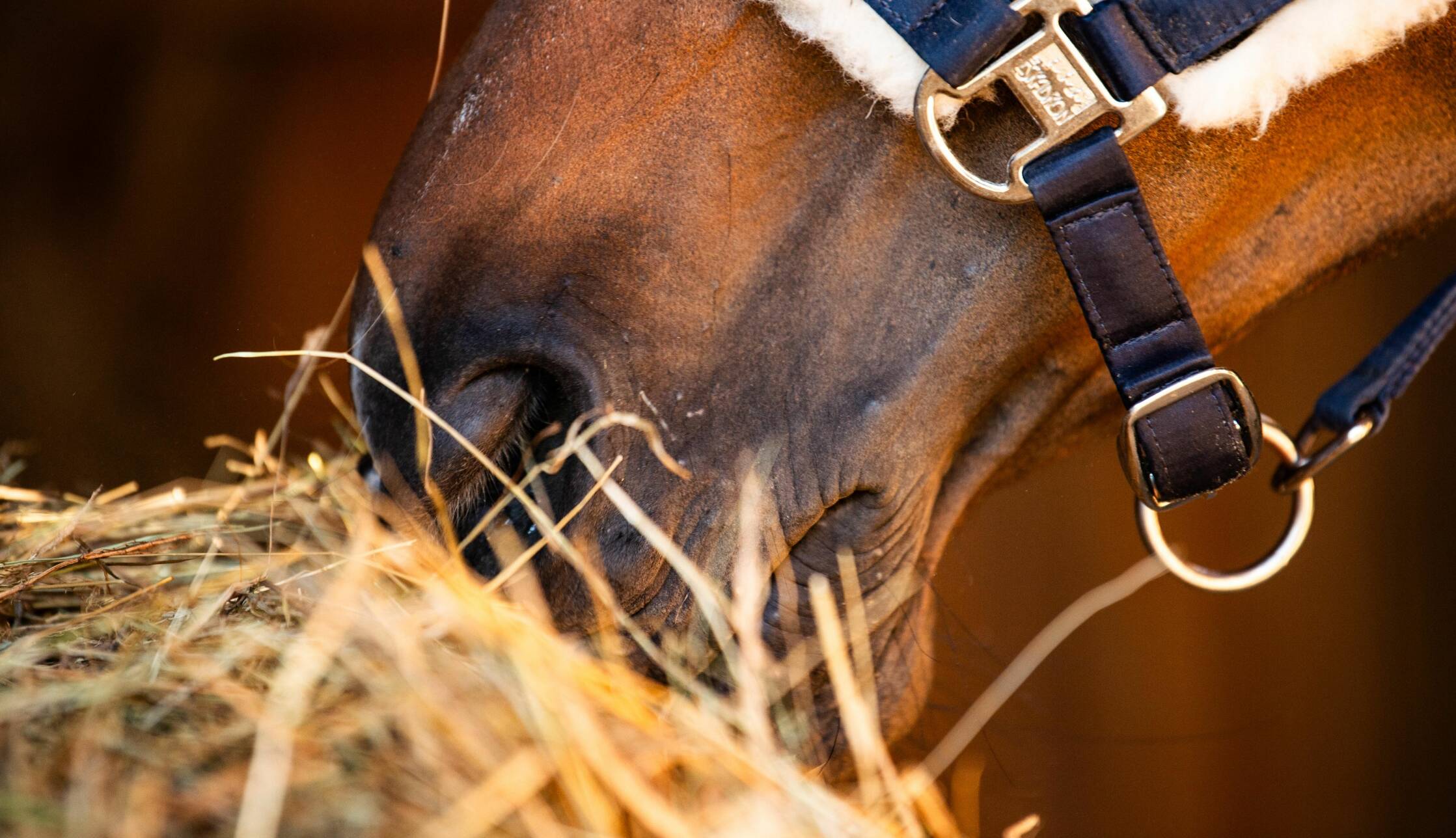
Be realistic about the type of horse
One of the things we often forget to look at when we feed our horses is the workload. How much exercise is your horse actually getting – and is it necessary with all the different kinds of supplements, for instance? All horses have a similar digestive system, but they can still have different needs depending on size, weight, breed, gender, season and workload.
“Of course, a mare with a foal needs a lot more energy than the horse that is just standing in the field, but most horse does not really need that much extra,” Martha Voss explains.
Provide enough roughage
Now that we understand how the digestive system of the horse works, we know that one of the most effective things we can do, is to make sure our horses' digestive system is as close to its natural as possible. And we do that by providing enough high-quality roughage. But what happens if the horse does not get enough roughage throughout the day?
Horses produce stomach acid 24 hours a day. This gives an almost constant flow of salvia, which contains the important enzymes and degrades the carbonates in its food. If the horse has no roughage, the stomach will be empty and it would be possible for the gastric acid to splash into the upper part of the stomach which for instance creates stomach ulcers. This condition is very painful for the horse, especially when it is being ridden and are changing in paces. This underlines the importance of why we need to look at the way we feed our horses when we experience difficulties in riding.
Contrarily, if your horse always has access to roughage, it will keep the stomach full and make sure that the stomach acid has something to digest, instead of attacking the stomach lining.
Providing roughage has another benefit and that is increased chewing time. Martha Voss explains:
“Time to chew will give you a horse that is much more calm, curious and easy to work with, so you really need to react if something is changing in the behaviour of your horse.”
And here the feeding is a really good place to start – and especially with the roughage.
“A horse needs to chew as this is still in their nature. They are used to moving and browsing a lot to find different kind of food during the day. They need at least eight hours to chew,” Martha Voss explains.
Lastly providing more roughage may decrease the amount of sugar and starch your horse receives. Both sugar and starch have an acidifying effect on the stomach acid and should, therefore, be kept to a minimum. That is why energy should rather come from the fibres in the roughage.
Overfeeding your horse can have huge consequences. Photo: Kamila Tworkowska.

Behaviour that might be connected to feeding:
Cribbing
Stress
Sudden pain when the girth is tightened
Problems during riding
Horse feed is not just food. It is essential for health, performance and behaviour what you feed your horse with. Photo: Kamila Tworkowska

If you take a further look at your horse's feeding regime, you might be surprised by how much the mental and physical condition is affected by the feed you provide your horse. Mental health is very connected to the horse's physical health if feeding wrongly.
A huge part of the daily horse feed should be roughage. Your horse always needs to have roughage, and to keep your horse happy and healthy, it should eat 1,5-2% of their body weight in roughage every day. As roughage is the main part of the daily feeding of your horse, you need to know what the roughage contains. And there is only one way to figure this out.
“Horse owners must always get an analysis on the roughage – and they need to know how to understand the analysis. If you understand this, it is a lot easier to adjust the hard feed for your horse,” Martha Voss explains.
You can get a professional to help analyse and understand the roughage. And as a matter of fact, most horses do not need a lot extra besides good roughage, fibres, fat, minerals and vitamins to keep them healthy and happy – mentally and physically.
“Have an analysis of your roughage – and learn to understand how it works. There is a measurement uncertainty, so if the analysis says 9% sugar you need to understand that it could also be 11% sugar. Despite of the measurement uncertainty it still gives you an indication of the sugar level, and that gives you the opportunity to adjust the hard feed,” Martha Voss explains.
“Are you feeding your horse candy or dry sticks with no energy? You simply must know this. When you know the amount of sugar, starch, protein and so on it is possible to make a right diet for your horse.”
So, it seems easy. But still, many of us are struggling with feeding our horses, and many of us may not be aware of how our horses' mental and physical health are immensely connected. That is why we need to know what we are feeding our hoses and which effects it has on them.
“Horse owners should know a lot more about what is actually in the horse feeds.”
- Martha Voss
Feeding for optimal mental health
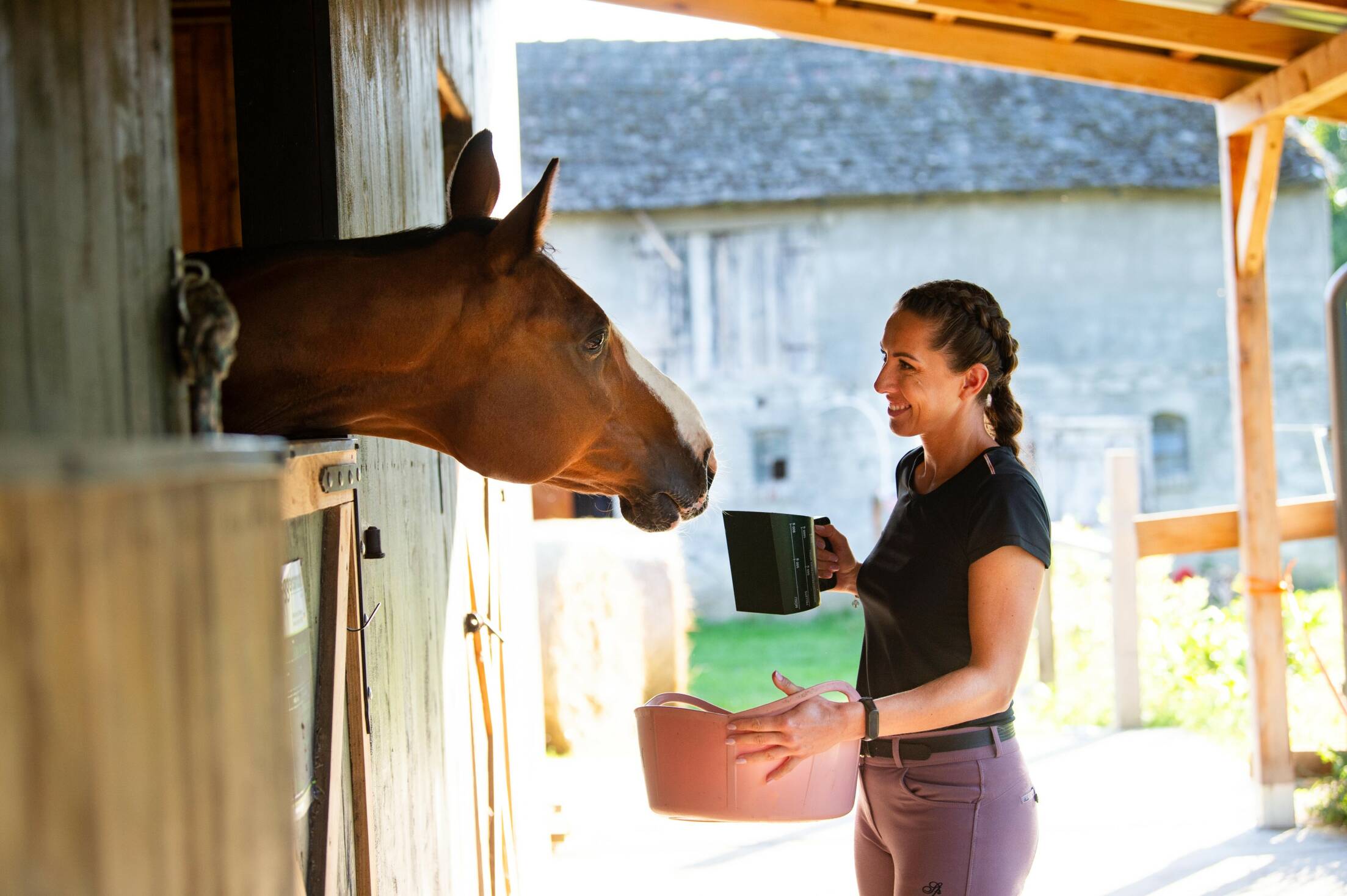
Have you ever considered how much feeding affects your horse's mental health and well-being? The short answer is a lot!
By Cæcilie Kallehave Jensen. Photos: Kamila Tworkowska
According to Martha Voss, you can sum it up to these three guidelines: Enough chewing time, an analysis of the roughage and a diet that is adapted to the workload for the horse and the horse's needs.
A minimum of 1,5 to 2 kilo dry matter roughage pr. 100 kg horse per day
Get an analysis of the roughage so you can adapt the rest of the feeding to this
Give the right amount of food – small, but many meals during the day
Keep your horse moving
Make sure your horse gets enough fibres and fat
Minimize intake of sugar and starch-based feeds
Provide something to chew on 24/7
It has been proved that the gastrointestinal tract serves as a direct communication channel to the central nervous system. Referred to as the gut-brain axis, it is a two-way communication system between the gut and the brain.
It has been suggested that up to 9 out of 10 communication signals runs from the gut to the brain, and just one from the brain to the gut. This underlines the importance of a healthy gut, to have a reasonable horse.
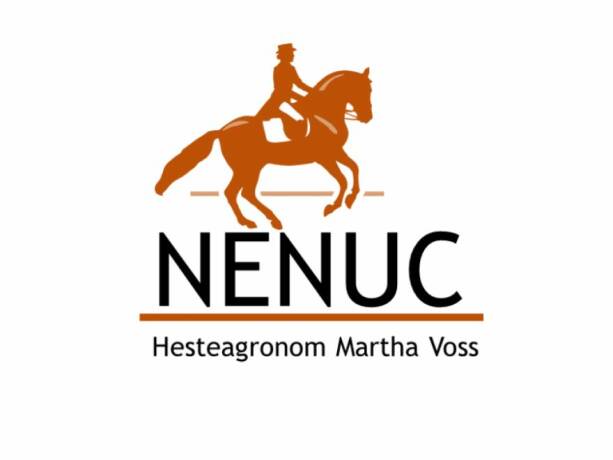
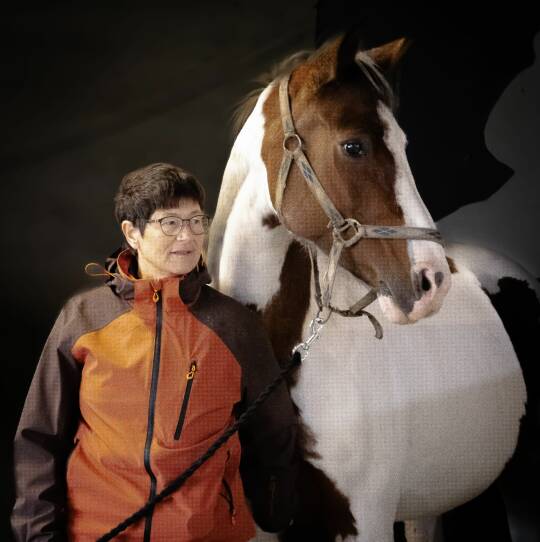
Martha Voss is a horse agronomist and runs the independent consulting and course business, NENUC, with courses, consulting visits and development of learning games for horse owners. Martha has more than 30 years of experience with teaching and researching in the field of horse management and correct nutrition.
Understand the digestive system of the horse
We must realize that the digestive system of the hose has not changed a lot since horses first developed. Yet, we are still trying to get the horse to adapt into our system and way of living instead of the other way around.
The stomach of the horses consists of two parts, but it is only the lower part which is protected from the stomach acid. The stomach is constantly producing the acid to for instance digest the food. Actually, the horses’ stomach is quite small, and it constitutes only 10% of the collected digestive system – a good thing in nature where the horse always needs to be ready to run without too much food in the stomach. This also mean that the food disappears quite quickly from the stomach.
The horse's cecum and large intestine are arranged so that it can utilize the coarse steppe grasses. They form large fermentation chambers, where microorganisms ferment the fibers and convert them into fatty acids, vitamins and so, which the horse can use in its energy metabolism.
The calm horse has a well-functioning large intestine as well.
Don’t overfeed your horse
Obviously, do not feed your horse with more food than it needs. But with this point, it is meant that there is no doubt that most horse owners like to take care of and feed their horses. Feeding is a huge part of management, but in our eager to take good care of our horses, we often end up almost doing too much.
"We like to give our horses treats and supplements. But we need to think about if the horses actually need it. When I go through the feed room with horse owners it is often possible for me to take out a whole closet with feed supplements that the horse actually does not need,” Martha Voss explains.
It is both costly and time-consuming to feed our horse all the different supplements – especially if the horse does not need all of them. So how do we figure out what to feed and not feed each individual horse? Firstly, we need to understand their digestive system.
Know what you are feeding your horse

Professor Jo-Anne Murray, May 2020: The gut-brain connection in horses. Premier Performance
Succeed Veterinary Center, May 2023: The Relationship Between Bacterial Environment in the Gut and the Brain in Horses.
Sources:
Diseases that might be connected to feeding:
Ulcers
Colic
Laminitis
Over- or underweight
Roughage should be an important part of your horse's diet. Photo: Shutterstock

Since we keep our horses quite differently to the natural horse, it can be challenging to feed natural, but with some slight adjustments, we might get a little bit closer.
Even though we have a huge responsibility as horse owners, there is also a responsibility from the feeding industry. They are responsible for providing clear ingredient labels and transparency. When reading on the back of the feedbag, you might be confused by the many different things in the feed – and how do you figure out what is essential for your horse and what is not?
“It is first of all our responsibility as horse owners to make sure that we feed our horses in a right way. We need to learn how to understand the information on the feedbag,” Martha Voss explains. But no matter how hard we try to feed our horses the right way, we may still need some help from the feed industry.
“The feed industry have a moral responsibility to tell horse owners what is in their feed – and this goes for both hard feed and roughage. But it is a bit more difficult with the roughage than with the hard feed. In the hard feed there is a law about feed materials and what they contain – but since roughage is a raw material it gets a bit more tricky, and there is no law to declare what the feeding actually contains. So, that is why we need to demand the analysis of the roughage a lot more,” Martha Voss explains.
Feeding is an individual case, and hardly any owner feeds the same. But it shows that trends tend to spread throughout the communities and are ever-changing. We are constantly figuring out new ways to feed our horses.
“I sense that ‘low on sugar and starch’ became a plus word in a lot of feeding. But actually, it does not make that big a difference if the hard feed might be low on sugar and starch if the roughage is filled with it instead.”
How do you feed your horse? Do you know what your feed bags contain? Do not hesitate to contact an educated and experienced feed consultant. Many places offer a free consultation. Remember that you are responsible for your horse's physical and mental well-being.
Owners, as well as feed industry, are responsible
Stereotypic behaviour like cribbing for instance is a way for the horse to get close to the natural behaviour of chewing. Photo: Shutterstock
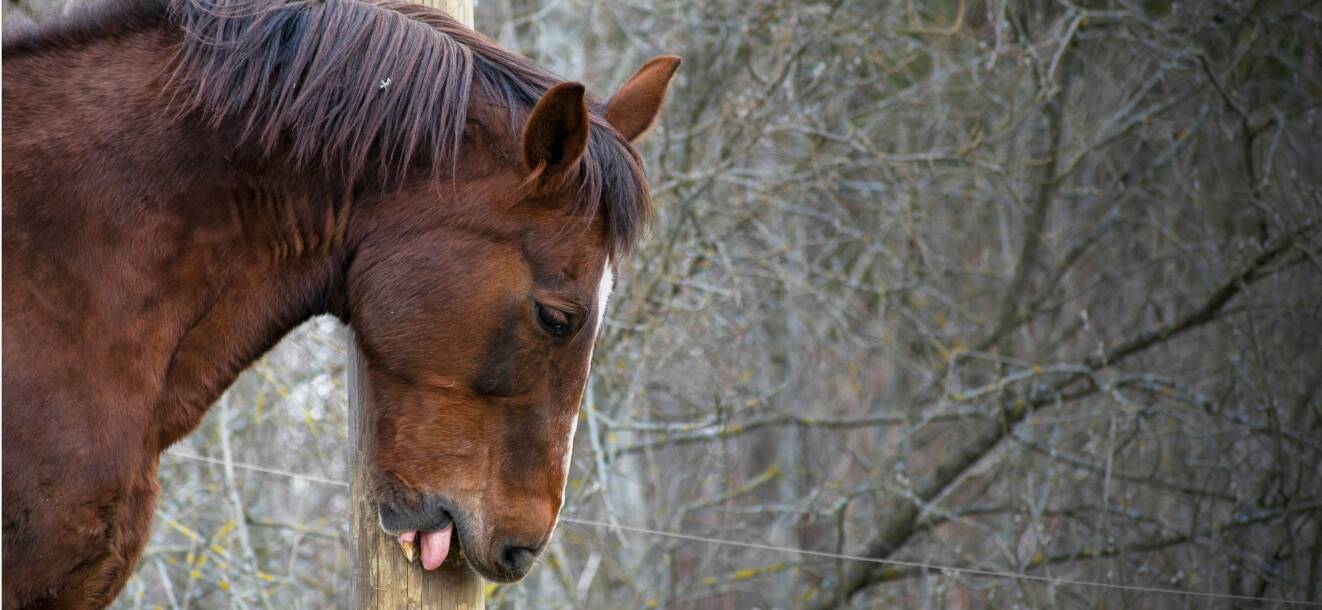
Today, we keep our horses in the stable for a lot of hours and often without enough roughage – or roughage in a quality that is not suitable for horses. When we see problems – mentally or physical – in our horses we often end up buying a lot of different subsidies instead of looking deeper into the environment we are offering our horses. An environment, that is very far away from the horse's natural environment. In nature, the horse would spend around 17 hours browsing, walking and searching for food. It would eat small rations with a lot of fibres throughout day – but that is far from how most horses are kept today.
When something is wrong within the stomach, it will often cause, what we perceive as, unwanted behaviour and a lot of diseases. Of course, feeding is not always the reason, but looking at the feeding can be a good place to start. We need to know, how well connected the horses’ gut and brain is connected.
Are we compromising the horse's digestive system in modern horse keeping?
“If your horse starts to get aggressive you need to react and might as well have a further look at the feeding. We must understand that we cannot just not treat symptoms. And we must figure of what causes the symptoms.”
Martha Voss explains.
According to Martha Voss, you can sum it up to these three guidelines: Enough chewing time, an analysis of the roughage and a diet that is adapted to the workload for the horse and the horse's needs.
A minimum of 1,5 to 2 kilo dry matter roughage pr. 100 kg horse per day
Get an analysis of the roughage so you can adapt the rest of the feeding to this
Give the right amount of food – small, but many meals during the day
Keep your horse moving
Make sure your horse gets enough fibres and fat
Minimize intake of sugar and starch-based feeds
Provide something to chew on 24/7
Be realistic about the type of horse
One of the things we often forget to look at when we feed our horses is the workload. How much exercise is your horse actually getting – and is it necessary with all the different kinds of supplements, for instance? All horses have a similar digestive system, but they can still have different needs depending on size, weight, breed, gender, season and workload.
“Of course, a mare with a foal needs a lot more energy than the horse that is just standing in the field, but most horse does not really need that much extra,” Martha Voss explains.
Now that we understand how the digestive system of the horse works, we know that one of the most effective things we can do, is to make sure our horses' digestive system is as close to its natural as possible. And we do that by providing enough high-quality roughage. But what happens if the horse does not get enough roughage throughout the day?
Horses produce stomach acid 24 hours a day. This gives an almost constant flow of salvia, which contains the important enzymes and degrades the carbonates in its food. If the horse has no roughage, the stomach will be empty and it would be possible for the gastric acid to splash into the upper part of the stomach which for instance creates stomach ulcers. This condition is very painful for the horse, especially when it is being ridden and are changing in paces. This underlines the importance of why we need to look at the way we feed our horses when we experience difficulties in riding.
Contrarily, if your horse always has access to roughage, it will keep the stomach full and make sure that the stomach acid has something to digest, instead of attacking the stomach lining.
Providing roughage has another benefit and that is increased chewing time. Martha Voss explains:
“Time to chew will give you a horse that is much more calm, curious and easy to work with, so you really need to react if something is changing in the behaviour of your horse.”
And here the feeding is a really good place to start – and especially with the roughage.
“A horse needs to chew as this is still in their nature. They are used to moving and browsing a lot to find different kind of food during the day. They need at least eight hours to chew,” Martha Voss explains.
Lastly providing more roughage may decrease the amount of sugar and starch your horse receives. Both sugar and starch have an acidifying effect on the stomach acid and should, therefore, be kept to a minimum. That is why energy should rather come from the fibres in the roughage.
Provide enough roughage
It has been proved that the gastrointestinal tract serves as a direct communication channel to the central nervous system. Referred to as the gut-brain axis, it is a two-way communication system between the gut and the brain.
It has been suggested that up to 9 out of 10 communication signals runs from the gut to the brain, and just one from the brain to the gut. This underlines the importance of a healthy gut, to have a reasonable horse.

We must realize that the digestive system of the hose has not changed a lot since horses first developed. Yet, we are still trying to get the horse to adapt into our system and way of living instead of the other way around.
The stomach of the horses consists of two parts, but it is only the lower part which is protected from the stomach acid. The stomach is constantly producing the acid to for instance digest the food. Actually, the horses’ stomach is quite small, and it constitutes only 10% of the collected digestive system – a good thing in nature where the horse always needs to be ready to run without too much food in the stomach. This also mean that the food disappears quite quickly from the stomach.
The horse's cecum and large intestine are arranged so that it can utilize the coarse steppe grasses. They form large fermentation chambers, where microorganisms ferment the fibers and convert them into fatty acids, vitamins and so, which the horse can use in its energy metabolism.
The calm horse has a well-functioning large intestine as well.
Overfeeding your horse can have huge consequences. Photo: Kamila Tworkowska.
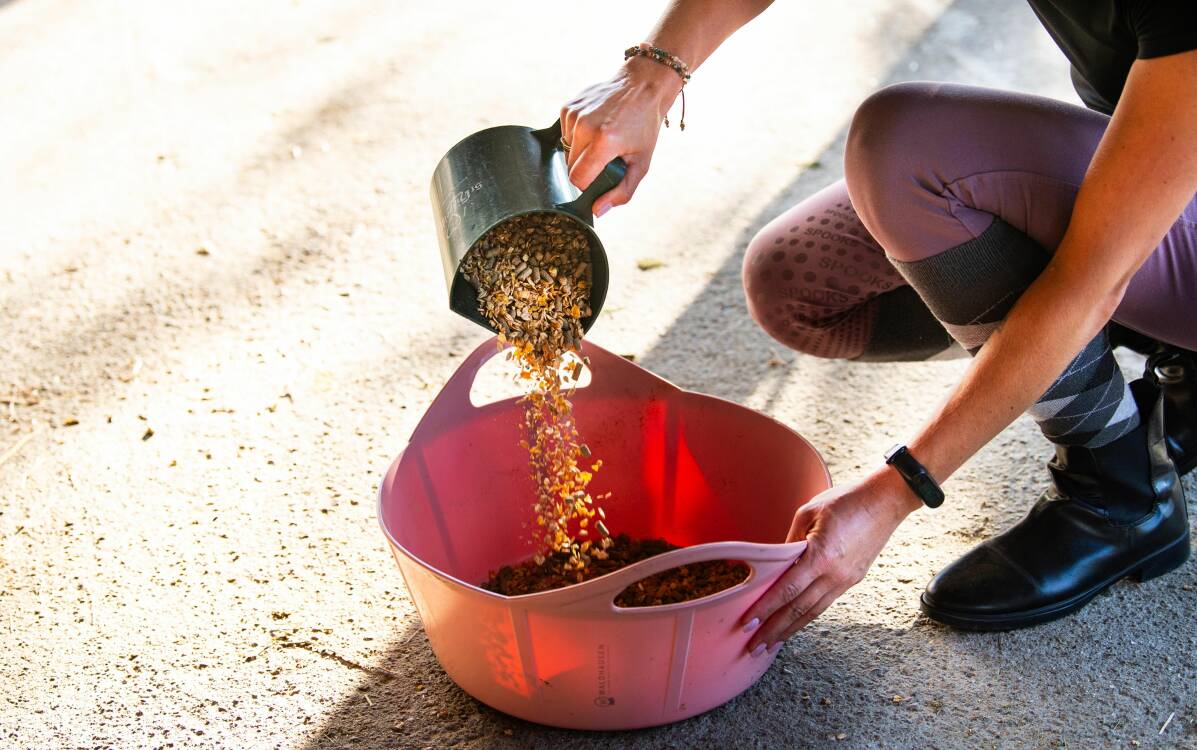
Understand the digestive system of the horse
gut-brain connection
Make sure you have good quality roughage and that you provide enough. Photo: Kamila Tworkowska
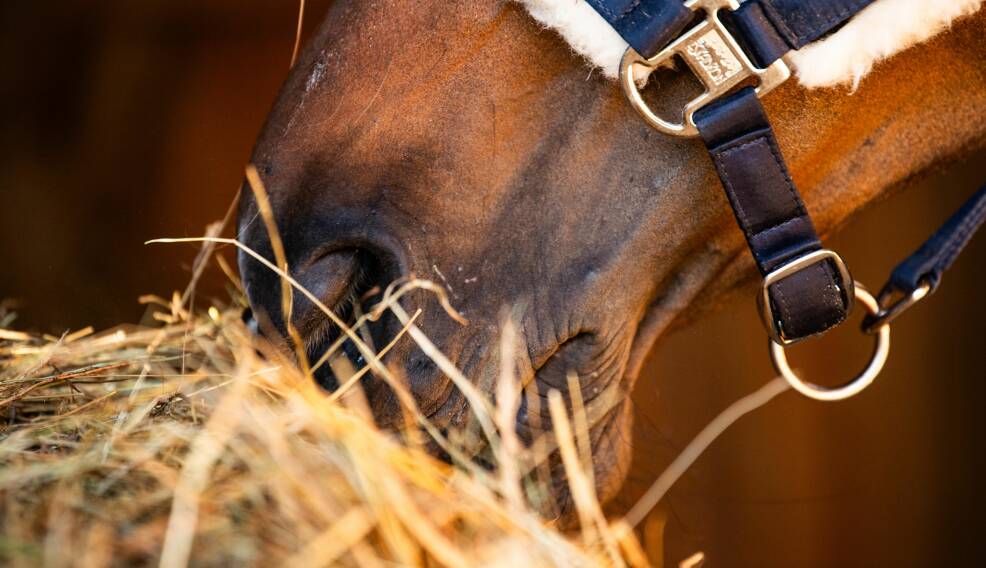
Obviously, do not feed your horse with more food than it needs. But with this point, it is meant that there is no doubt that most horse owners like to take care of and feed their horses. Feeding is a huge part of management, but in our eager to take good care of our horses, we often end up almost doing too much.
"We like to give our horses treats and supplements. But we need to think about if the horses actually need it. When I go through the feed room with horse owners it is often possible for me to take out a whole closet with feed supplements that the horse actually does not need,” Martha Voss explains.
It is both costly and time-consuming to feed our horse all the different supplements – especially if the horse does not need all of them. So how do we figure out what to feed and not feed each individual horse? Firstly, we need to understand their digestive system.
Don’t overfeed your horse
Behaviour that might be connected to feeding:
Cribbing
Stressed
Sudden pain when the girth is tightened
Problems during riding
Horse feed is not just food. It is essential for health, performance and behaviour what you feed your horse with. Photo: Kamila Tworkowska
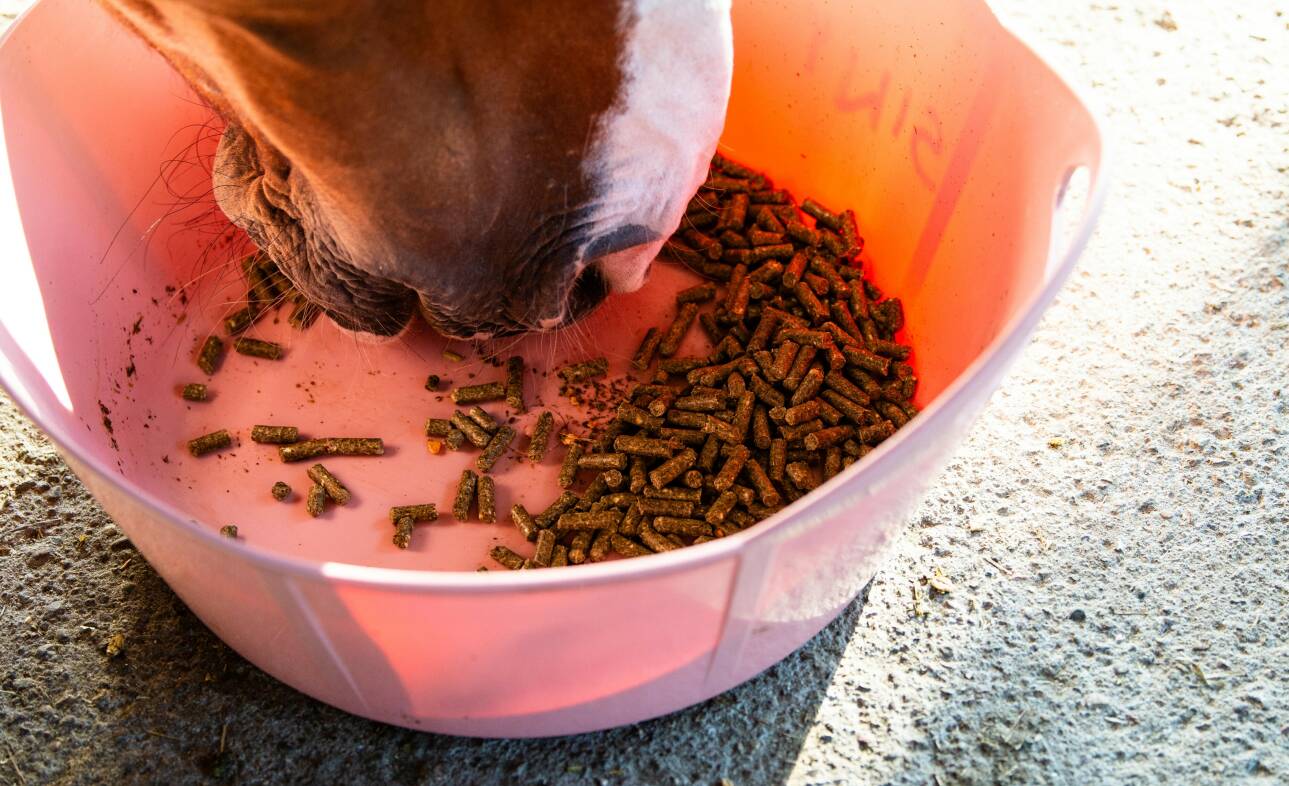
If you take a further look at your horse's feeding regime, you might be surprised by how much the mental and physical condition is affected by the feed you provide your horse. Mental health is very connected to the horse's physical health if feeding wrongly.
A huge part of the daily horse feed should be roughage. Your horse always needs to have roughage, and to keep your horse happy and healthy, it should eat 1,5-2% of their body weight in roughage every day. As roughage is the main part of the daily feeding of your horse, you need to know what the roughage contains. And there is only one way to figure this out.
“Horse owners must always get an analysis on the roughage – and they need to know how to understand the analysis. If you understand this, it is a lot easier to adjust the hard feed for your horse,” Martha Voss explains.
You can get a professional to help analyse and understand the roughage. And as a matter of fact, most horses do not need a lot extra besides good roughage, fibres, fat, minerals and vitamins to keep them healthy and happy – mentally and physically.
“Have an analysis of your roughage – and learn to understand how it works. There is a measurement uncertainty, so if the analysis says 9% sugar you need to understand that it could also be 11% sugar. Despite of the measurement uncertainty it still gives you an indication of the sugar level, and that gives you the opportunity to adjust the hard feed,” Martha Voss explains.
“Are you feeding your horse candy or dry sticks with no energy? You simply must know this. When you know the amount of sugar, starch, protein and so on it is possible to make a right diet for your horse.”
So, it seems easy. But still, many of us are struggling with feeding our horses, and many of us may not be aware of how our horses' mental and physical health are immensely connected. That is why we need to know what we are feeding our hoses and which effects it has on them.
Know what you are feeding your horse
“Horse owners should know a lot more about what is actually in the horse feeds.”
- Martha Voss
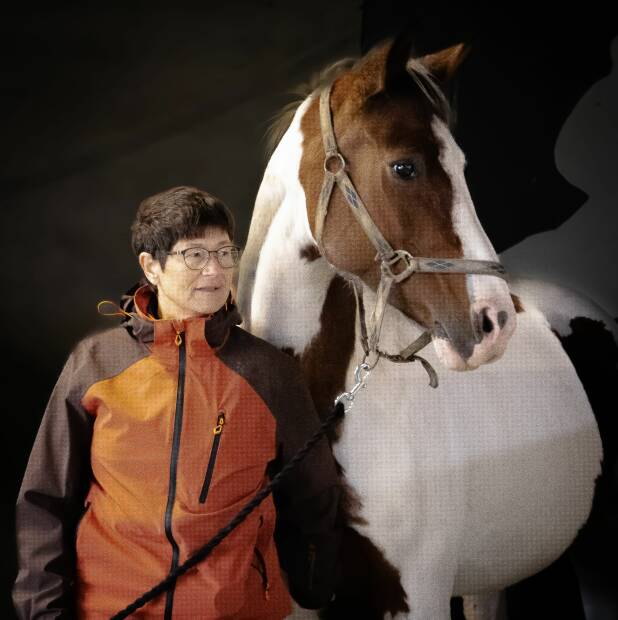
Martha Voss is a horse agronomist and runs the independent consulting and course business, NENUC, with courses, consulting visits and development of learning games for horse owners. Martha has more than 30 years of experience with teaching and researching in the field of horse management and correct nutrition.
Simple as that if you ask horse agronomist Martha Voss. As horse owners we simply must know what we actually are feeding our horses – and we need to know how the behaviour in our horses are connected to the feeding. We have talked to feed expert Martha Voss about all the do’s and don’ts when it comes to feeding for optimal mental health in horses.
Feeding for optimal mental health
Have you ever considered how much feeding affects your horse's mental health and well-being? The short answer is a lot!
By Cæcilie Kallehave Jensen. Photos: Kamila Tworkowska
